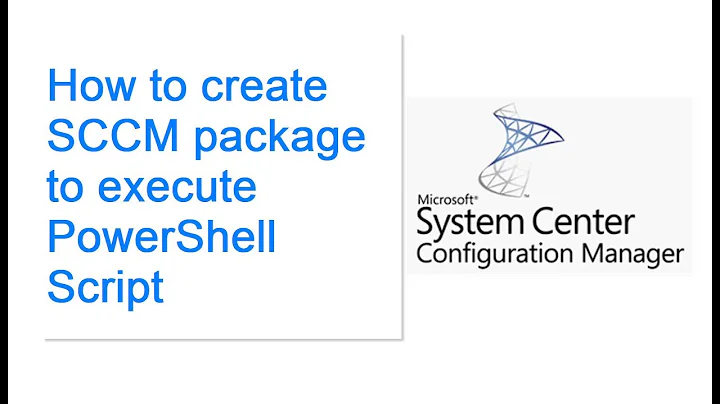In what context do SCCM Powershell detection scripts run in?
Empirical Results
I wrote some PowerShell that, when run as a detection script, dumps the environment variables that the detection script sees to a log file. That script is at the end of this answer.
I then cause this script to be run by the SCCM client by deploying a Deployment Type with different "Installation Behavior" and "Logon requirement" parameters. The results are in the table below:
Test InstallationBehavior LogonRequirement DeployedTo LoggedOnUser ScriptRunAs
---- -------------------- ---------------- ---------- ------------ -----------
1.1a Install for user Only when a user is logged on un2 un2 un2
1.1b Install for user Only when a user is logged on cn1 un2 un2
1.1c Install for user Only when a user is logged on cn1 un1 un1
1.2a Install for system Only when a user is logged on un2 un2 un2
1.2b Install for system Only when a user is logged on cn1 un2 cn1
1.2c Install for system Only when a user is logged on cn1 un1 cn1
1.3a Install for system Whether or not a user is logged on un2 un2 un2
1.3b Install for system Whether or not a user is logged on cn1 un2 cn1
1.3c Install for system Whether or not a user is logged on cn1 un1 cn1
-
unXare usernames -
cnXare computer names
Analysis
The above results are surprising because the context that a detection script runs in seems to depend in part upon whether the Application was deployed to a user or a system. This was enough of a surprise that I ran the tests a second time. The results were consistent.
We can tentatively draw the following hypotheses from the table above:
- When an Application is deployed to a user, a PowerShell detection script for that Application is run as that user.
- When an Application is deployed to a system and the Deployment Type is installed for the system, a PowerShell detection script for that Application is run as the system.
- When an Application is deployed to a system and the Deployment Type is installed for the user, a PowerShell detection script for that Application is run as the logged-in user.
The above three hypotheses are supported by the test results. There may well be some other variables that weren't tested where these hypotheses do not hold. They are, at least, a good set of initial assumptions when using PowerShell detection scripts.
Mismatched Contexts (Beware!)
Jason Sandys documented a similar test of the rules for installation context. If you read that post carefully, you might notice that the rules for installation context and detection script context are not quite the same. Here are the offending rules:
When an Application's installation behavior is set to "Install as System" the installer is run as system [regardless of deployment to user].
When an Application is deployed to a user, a PowerShell detection script for that Application is run as that user [regardless of whether installation behavior is set to "Install as System"].
This means that an Application that has installation behavior “Install as system” and is deployed to a user collection will use the system context for installation, but the user context for detection.
Someone writing detection scripts for Applications where installation behavior is "Install as System" should be careful to avoid relying on any part of the environment that changes between the system and user contexts. Otherwise, detection of an Application deployed to a system collection may succeed while detection of the exact same Application deployed to a user collection fails.
Script
function Write-EnvToLog
{
$appName = 'script-detect-test'
$logFolderPath = "c:\$appName-$([System.Environment]::UserName)"
if ( -not (Test-Path $logFolderPath -PathType Container) )
{
New-Item -Path $logFolderPath -ItemType Directory | Out-Null
}
if ( -not (Test-Path $logFolderPath -PathType Container ) )
{
return
}
$logFileName = "$appName`__$((Get-Date).ToString("yyyy-MM-dd__HH-mm-ss")).txt"
$fp = "$logFolderPath\$logFileName"
Get-ChildItem Env: | Out-File $fp | Out-Null
return $true
}
try
{
if ( Write-EnvToLog ) { "Detected!" }
[System.Environment]::Exit(0)
}
catch
{
[System.Environment]::Exit(0)
}
Related videos on Youtube
BumberAZ
Updated on September 18, 2022Comments
-
BumberAZ over 1 year
This is the situation, I will write the example code:
user = 'Boby' a = ['hana', 'dul', 'se'] b = method.prepareSentence(a, user) first_sentence = method.prepareSpeech('short_speech', user, b) second_sentence = method.prepareDebates('quick_debates', user, b)but here I want a to have one more element in the list, so
a = ['hana', 'dul', 'se', 'sou']Is it possible to do this without duplicating variables and making two versions of a?
I found this solution but this is very primitive and will make the script bigger and I want to make changes to many other similar scripts:
a1 = ['hana', 'dul', 'se'] b1 = method.prepareSentence(a, user) a2 = ['hana', 'dul', 'se', 'sou'] b2 = method.prepareSentence(a, user)first_sentence = method.prepareSpeech('short_speech', user, b1) second_sentence = method.prepareDebates('quick_debates', user, b2)
-
 Selcuk over 2 yearsThat's not a dictionary; it's a set. You can do
Selcuk over 2 yearsThat's not a dictionary; it's a set. You can doa2 = a1 | {"sou"}with sets. -
BumberAZ over 2 yearsYou are right @Selcuk I am still mixing up the terms, I am a beginner. What you suggest is of course better and shorter way but, doesn't it still mean that I have to use two different variables?
-
Blckknght over 2 yearsAre you looking for
a.append('sou')? Lists (which you're using now) also support the+operator, if you want to create a new list with the extra element (a + ['sou']). -
 Selcuk over 2 yearsThis sounds like an XY problem. Maybe you should first explain why you think you need to do this in the first place. Are there too many variables that need to be created? If yes, it smells bad design.
Selcuk over 2 yearsThis sounds like an XY problem. Maybe you should first explain why you think you need to do this in the first place. Are there too many variables that need to be created? If yes, it smells bad design.
-
-
 MDMoore313 almost 9 years+1 for a solid SCCM question and answer. I do hope the SCCM community here grows as it's really the only thing I keep a look out for (email subscription for the tags.) Here, have some extra rep as a motivation to keep 'em comin.
MDMoore313 almost 9 years+1 for a solid SCCM question and answer. I do hope the SCCM community here grows as it's really the only thing I keep a look out for (email subscription for the tags.) Here, have some extra rep as a motivation to keep 'em comin. -
alx9r almost 9 yearsThanks @BigHomie. I'm filtering for SCCM too...but I miss a bunch because there's no practical way to get that filtered stream on mobile.
-
 Admin almost 9 yearsExcellent SCCM question! Come join @BigHomie and I - custodians of the [sccm] tag. There are literally a couple of us.
Admin almost 9 yearsExcellent SCCM question! Come join @BigHomie and I - custodians of the [sccm] tag. There are literally a couple of us. -
 MDMoore313 almost 9 yearsDarn Skippy, @kce has the best questions this side of the Windows tag too.
MDMoore313 almost 9 yearsDarn Skippy, @kce has the best questions this side of the Windows tag too. -
BumberAZ over 2 yearsI am embarrassed for calling it a dictionary instead of a set. That operator is very helpful but I was thinking if there is another way to do it without creating new variables, but I guess that's impossible
-
Matiiss over 2 years@BumberAZ you can use a list or an actual dictionary and add the new values there, that way you can access them by their keys or indexes and it wouldn't take up the namespace




